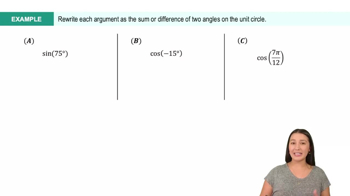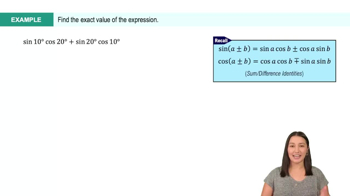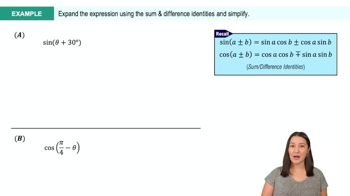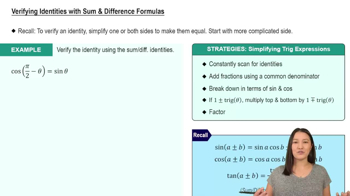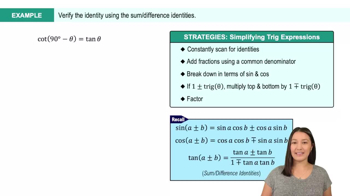Table of contents
- 0. Review of College Algebra4h 43m
- 1. Measuring Angles39m
- 2. Trigonometric Functions on Right Triangles2h 5m
- 3. Unit Circle1h 19m
- 4. Graphing Trigonometric Functions1h 19m
- 5. Inverse Trigonometric Functions and Basic Trigonometric Equations1h 41m
- 6. Trigonometric Identities and More Equations2h 34m
- 7. Non-Right Triangles1h 38m
- 8. Vectors2h 25m
- 9. Polar Equations2h 5m
- 10. Parametric Equations1h 6m
- 11. Graphing Complex Numbers1h 7m
6. Trigonometric Identities and More Equations
Sum and Difference Identities
Problem 5.56c
Textbook Question
Use the given information to find the quadrant of s + t. See Example 3.
cos s = -1/5 and sin t = 3/5, s and t in quadrant II
 Verified step by step guidance
Verified step by step guidance1
<Step 1: Understand the problem. We need to determine the quadrant of the angle s + t given that cos(s) = -1/5 and sin(t) = 3/5, with both angles s and t located in quadrant II.>
<Step 2: Recall the properties of trigonometric functions in quadrant II. In quadrant II, cosine is negative and sine is positive. This is consistent with the given values: cos(s) = -1/5 and sin(t) = 3/5.>
<Step 3: Determine the signs of sin(s) and cos(t) using the quadrant information. Since s is in quadrant II, sin(s) is positive. Similarly, since t is in quadrant II, cos(t) is negative.>
<Step 4: Use the angle addition formulas to find the signs of sin(s + t) and cos(s + t). The formulas are: sin(s + t) = sin(s)cos(t) + cos(s)sin(t) and cos(s + t) = cos(s)cos(t) - sin(s)sin(t).>
<Step 5: Analyze the signs of sin(s + t) and cos(s + t) to determine the quadrant of s + t. If sin(s + t) is positive and cos(s + t) is negative, s + t is in quadrant II. If both are negative, s + t is in quadrant III. If sin(s + t) is negative and cos(s + t) is positive, s + t is in quadrant IV.>
Recommended similar problem, with video answer:
 Verified Solution
Verified SolutionThis video solution was recommended by our tutors as helpful for the problem above
Video duration:
0m:0sPlay a video:
Was this helpful?
Key Concepts
Here are the essential concepts you must grasp in order to answer the question correctly.
Trigonometric Functions
Trigonometric functions, such as sine and cosine, relate the angles of a triangle to the ratios of its sides. In this context, cos(s) = -1/5 indicates that angle s has a cosine value in the second quadrant, where cosine is negative. Similarly, sin(t) = 3/5 shows that angle t has a sine value in the second quadrant, where sine is positive.
Recommended video:

Introduction to Trigonometric Functions
Quadrants of the Coordinate Plane
The coordinate plane is divided into four quadrants, each defined by the signs of the x (cosine) and y (sine) coordinates. Quadrant I has both positive sine and cosine, Quadrant II has a negative cosine and positive sine, Quadrant III has both negative sine and cosine, and Quadrant IV has a positive cosine and negative sine. Understanding these quadrants is essential for determining the signs of trigonometric functions based on the angles.
Recommended video:

Quadratic Formula
Sum of Angles in Trigonometry
The sum of angles in trigonometry involves finding the sine and cosine of the sum of two angles, s and t, using the formulas: sin(s + t) = sin(s)cos(t) + cos(s)sin(t) and cos(s + t) = cos(s)cos(t) - sin(s)sin(t). To find the quadrant of s + t, one must evaluate the signs of these resulting sine and cosine values, which will indicate the quadrant in which the angle s + t lies.
Recommended video:
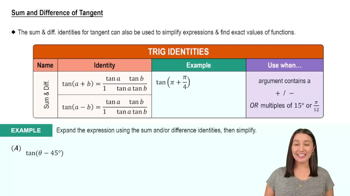
Sum and Difference of Tangent

 6:14m
6:14mWatch next
Master Sum and Difference of Sine & Cosine with a bite sized video explanation from Callie Rethman
Start learningRelated Videos
Related Practice



